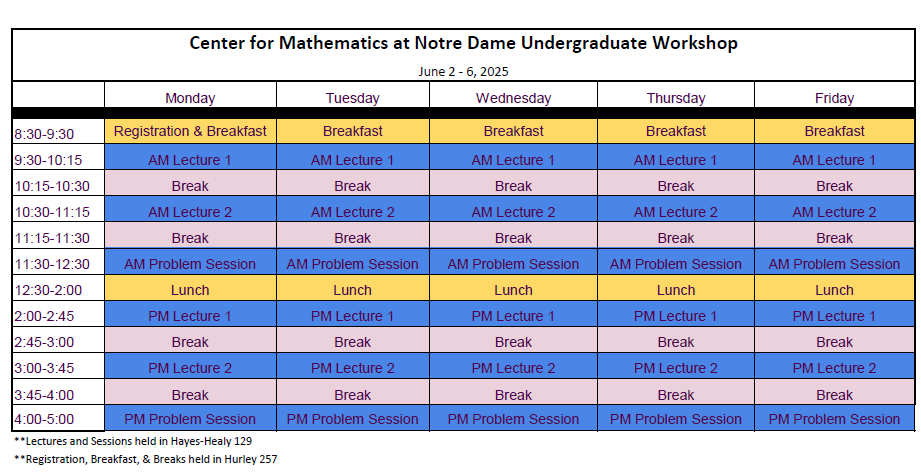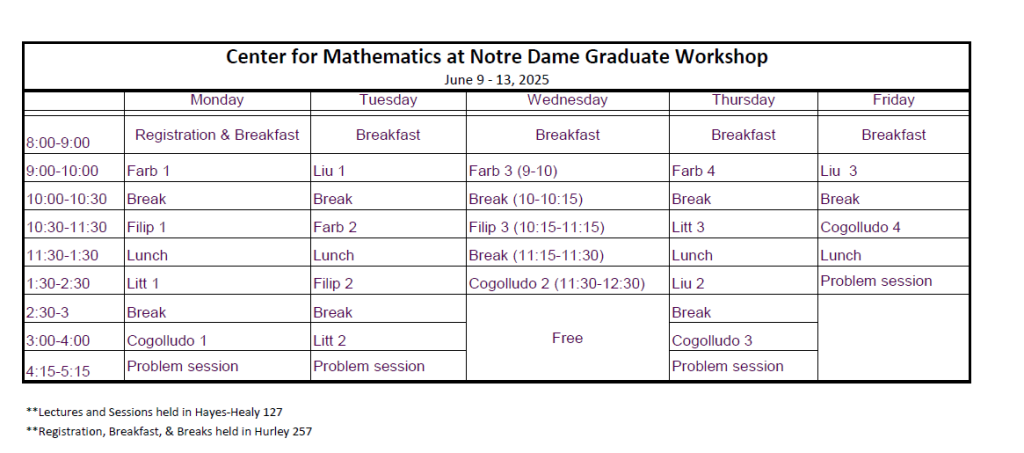Jose Cogolludo
TITLE: Fundamental Groups of Quasi-Projective Varieties
ABSTRACT: We will discuss the topology of quasiprojective varieties from the point of
view of fundamental groups and their invariants. We will describe different
techniques to calculate them in the particular case of complements of curves
in the projective plane. We will review braid monodromy, covering
transformations, birational morphisms, and positivity conditions to study such
groups. Zariski pairs will be introduced and described in detail in some
cases, such as, Alexander equivalent Zariski pairs, or arithmetic Zariski
pairs.
Also, time permitting, a general view into Alexander polynomials,
characteristic varieties, and twisted Alexander polynomials will be provided.
NOTES: https://sites.nd.edu/cmnd2025-thematic-program/files/2025/06/Cogolludo_Notes.pdf
Benson Farb
TITLE: A crash course on mapping class groups of 4-manifolds from a Thurstonian viewpoint
ABSTRACT: This will be a minicourse on some of the basic themes and methods from the theory of mapping class groups of 4-manifolds inspired by Thurston’s approach for 2-manifolds. Part of the appeal of the subject is the mixture of ideas from topology (intersection forms, monodromy of fiber bundles); geometric group theory (reflection groups, arithmetic groups); algebraic geometry (elliptic fibrations, K3 surfaces, Hodge theory); differential geometry (spaces of Ricci-flat metrics); and more. The field is still in its infancy, and many open questions will be posed.
PREPARATION: Attendees are encouraged to watch the three “July Lectures” from the web page: https://math.uchicago.edu/~farb/ModM4/ModM4-webpage
The videos on this web page are a 3 lecture course on “what you need to know from algebraic geometry to get started on 4-manifolds, for people who only know Hatcher.”
Simion Filip
TITLE: Hodge theory of character varieties of surface groups
ABSTRACT: Much of the geometry of a Riemann surface is controlled by its fundamental group and various topological and complex-analytic or algebraic objects associated to it. One much-studied setup considers the abelianization of the fundamental group, which leads to the first homology (a topological object), holomorphic 1-forms and the Jacobian variety parametrizing degree zero line bundles (complex-analytic/algebraic objects). After reviewing this case from the perspective of Hodge theory, we will move on to look at a non-abelian version: the character variety which parametrizes representations of the fundamental group into a given algebraic group, such as GL(n). Analogously to the abelian case, we will discuss associated complex-analytic/algebraic structures and how they depend on the underlying Riemann surface structure.
Daniel Litt
TITLE: Fundamental groups of algebraic varieties
ABSTRACT: Among, say, topological spaces or even smooth manifolds, complex algebraic varieties are extremely special. The algebraic origin of a variety X endows its topological invariants with extra structure — Hodge structures, Galois actions, and so on. I’ll discuss the implications of some of this extra structure for fundamental groups of algebraic varieties, and for their representations. The basic questions here will be: what groups can arise as fundamental groups of algebraic varieties? And how can the structures with which they are endowed be used to prove concrete statements about them?
EXERCISES: https://sites.nd.edu/cmnd2025-thematic-program/files/2025/06/Litt_Exercises-1.pdf
Yuan Liu
TITLE: Distribution of class groups and their nonabelian generalizations
ABSTRACT: This mini-course explores the Cohen–Lenstra program, which investigates the distribution of class groups—and their nonabelian generalizations—across families of global fields. I will begin with an introduction to the subject and its historical development, including a review of the necessary background in algebraic number theory and an overview of the original Cohen–Lenstra heuristics.
The course will then focus on two major threads of recent progress:
- Group/Galois-theoretic aspect: The nonabelian analogues of class groups are the Galois groups of maximal unramified extensions. Understanding their distribution requires a detailed grasp of their group-theoretic structure. I will discuss techniques and results related to presenting these Galois groups explicitly.
- Geometric aspect: In the function field setting, the Cohen–Lenstra heuristics can be reformulated as questions about counting points on Hurwitz spaces. I will outline this connection and present the proof of a moment version of the Cohen–Lenstra heuristics in the function field ase.
EXERCISES: https://sites.nd.edu/cmnd2025-thematic-program/files/2025/06/Liu_Problem_List.pdf

